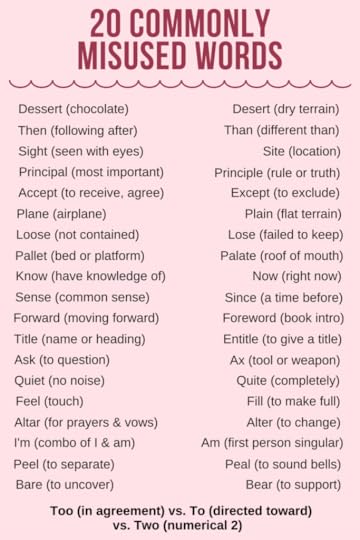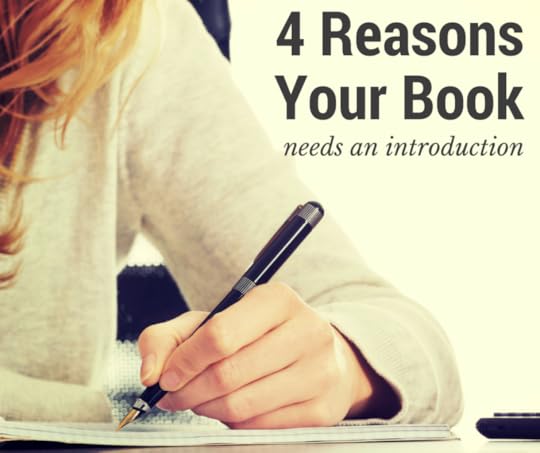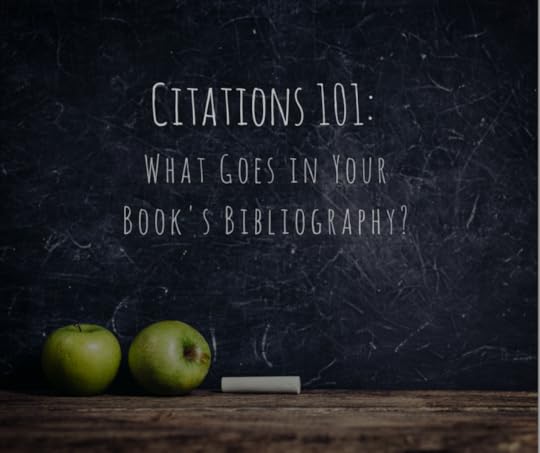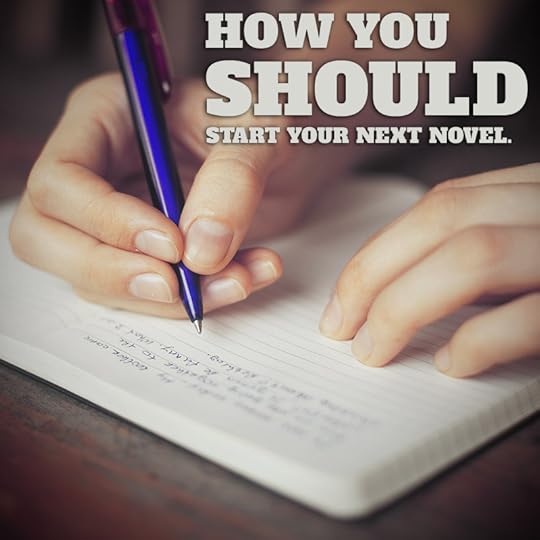Peter Lopez Jr.'s Blog: Xulon Press Blog , page 37
April 1, 2016
20 Commonly Misused Words
We remember it fondly from our elementary school days: if you can’t recall how to spell a word, sound it out! As adults, we might follow the same tactic when trying to rack our brains to produce that one word we know how to spell, but can’t piece together the correct letters.
However, sounding out words in print instead of in conversation could lead to the right word being written, but maybe not the right meaning for the word. For example, “I’m going to take the plain” is not the correct spelling of the word needed: this form means traversing a flat piece of land (plain) instead of boarding a mode of transportation (plane).
Below are several commonly misspelled words that you may not realize had different forms of spelling. Be careful to use these words as they could change how your sentence is read!

The post 20 Commonly Misused Words appeared first on Xulon Press, Christian Self Publishing.
March 25, 2016
With Childlike Faith: A New Way to Look at the Crucifixion

By Elizabeth Marrero
She hung close to her mom as she watched the man carrying a cross down the aisle. She let out a shriek and tried to run to help him when they whipped his back. She cried with him, helpless as she watched the horrible scene unfold before her, so emotional that she had to be carried away.
The deep sorrow and inexpressible joy that comes with the resurrection story is incomparable. Written by the finger of God from the beginning of time, it is unlike any story that could ever be written by man.
During this time of the year, we hear this story in many different ways. We see various displays of the cross, so much that we run the risk of becoming desensitized to it all. But seeing my niece’s reaction to watching her dad play the part of Jesus in the church’s Easter play brought it back to reality.
In her eyes, the man that meant the world to her, who she loved with all her heart and soul, was being attacked, going through such suffering, and there was nothing she could do about it.
Jesus, however, said, “Let the little children come to me, and stop keeping them away, because the kingdom from heaven belongs to people like these” (Matt. 19:14, ISV).
Emotional? Yes, we were created as emotional beings, in reflection of God’s heart. Innocent? I hope so. I hope we have not lost the purity in our hearts that would be appalled by the evils the enemy inspires in this world. He tried to completely annihilate our Savior, and on the cross, it looked like he had succeeded. But that’s not the whole story.

Author Services Rep Elizabeth Marrero
Three days after Jesus’ crucifixion, he resurrected (just like He said), roaring with life in abundance like the Lion of Judah He is. “Why are you crying?” Jesus asked the woman looking for His dead body. He is alive; the victory has been won for us all; our God reigns!
I invite you to celebrate with us in the inexpressible joy and innocence of a child, to praise, sing, shout, and dance your heart out in worship to our triumphant King. Jesus said, “Remember Me,” and we do so with joy because we remember Him as victorious. Happy Resurrection Sunday!
The post With Childlike Faith: A New Way to Look at the Crucifixion appeared first on Xulon Press, Christian Self Publishing.
Video: Pastor G.F. Watkins Talks About Intense Men and His Book: The Alpha Male
Xulon Press sat down with G.F. Watkins, founding pastor of Powerhouse Church and author of The Alpha Male. We talked about what happened at the 2016 Intense Men Conference, the irreplaceable need for strong, godly men, and why he believes in “teaching until every man is taught.”
Check out Pastor Watkins’ books The Alpha Male and Take Your Place on the Xulon Press bookstore.
The post Video: Pastor G.F. Watkins Talks About Intense Men and His Book: The Alpha Male appeared first on Xulon Press, Christian Self Publishing.
March 23, 2016
Trending Now: Book Subscriptions in a Box!

Subscription boxes have become the new “thing” in recent years, as there is one for just about every kind of person, hobby, age, or even your pet.
Handpicked beauty products? There’s a box for that.
Toys and treats for your dog? There’s a box for that.
Featured wine of the month? There’s a box for that.
A book of the month box for your favorite genre? There’s a box for that too—and many of them, at that!
And these boxes are pretty genius, for many different reasons.
First, who doesn’t love getting stuff in the mail? And I’m not only talking about bills here; I’m talking actual, tangible “gifts to myself” each month.
Next, these boxes are typically not a “one size fits all.” Most of the boxes are tailored specifically to you and your taste only. You only like red wine, not white? There’s an option on the wine box for that. You’ve had enough of perfume samples? Then you can receive only hair products and makeup in your beauty box if you let them know. You only read young adult fiction? Check that option on your book subscription box—or subscribe to a specified young adult fiction box, which sends you a book, a handwritten note from the owner, and a small gift curated just for book lovers.
That’s exactly what one such subscription service, Uppercase, is doing.
“I’ll never send out a book I haven’t read and can’t vouch for myself,” says Uppercase owner and founder Lisa Parkin. “It’s part of what I offer—my personal recommendations for my subscribers.”
So, you don’t have to worry about receiving a “bad” book in your box. Someone whose opinion is valued by many has read it and knows the contents inside, so subscribers trust their “expert” opinion. Pretty awesome, right?
What’s another reason these subscription boxes are genius? They’re a tangible, easily measurable, amazing marketing tool for authors just like you.
Reach out to a owners of subscription boxes that cater to your genre. Ask if you can send them one of your books to read (and perhaps review). If they like it, they can purchase a print run to send to their subscribers in a future box. Just like that, you’ve gained hundreds—maybe even thousands—of readers, and if those readers like your book, they’ll recommend it to others, and so on.
Pretty soon, your book could spreading around the globe…all because of a subscription box!
The post Trending Now: Book Subscriptions in a Box! appeared first on Xulon Press, Christian Self Publishing.
March 18, 2016
The Best Writing Tool You Aren’t Using
 Everyone knows about a certain digital pinboard, known as the procrastinator’s best friend, the party planner’s go-to inspiration, and the foodie’s favorite recipe archive. But, as a writer, have you ever thought about how you can use Pinterest to develop your scene descriptions, hone your style, and actually see your characters take shape? Here are just some of the ways to use Pinterest for authors.
Everyone knows about a certain digital pinboard, known as the procrastinator’s best friend, the party planner’s go-to inspiration, and the foodie’s favorite recipe archive. But, as a writer, have you ever thought about how you can use Pinterest to develop your scene descriptions, hone your style, and actually see your characters take shape? Here are just some of the ways to use Pinterest for authors.
1. Online Inspiration Board
From characters to settings, there is no better way to write with powerful sensory detail than to be looking right at your inspiration. Think about creating boards for your protagonist, antagonist, and even other main characters so you can develop them as round, multi-dimensional people. What is their style? What clothes do they wear? Is their abode a warm, bohemian cottage on a hill or a high-end penthouse outfitted with cold stainless steel? Create boards for settings and pin different vantage points, bird’s-eye views, and other images that will give you, and your readers, a unique perspective of the scene.
2. Book Cover Ideas
Conveying the design in your head to the graphic designers can be difficult for both parties, but having a visual to point to changes everything. From font to imagery to general formatting, finding concrete examples will make sure the design process is easier for everyone—and that you end up with the look you want.
3. Theme and Topic Starters
Pinterest is absolutely loaded with quotes and images that are perfectly suited to spark your next great writing idea. Build a board with any interesting, provocative, or stimulating quotes or images you find. Whether you use it for daily writing exercise or it unfolds into your next novel, you can surely find inspiration on the thousands of Pinterest boards dedicated to meaningful ideas, photography, and illustrations from all over the world.
4. Writer Admiration
Keep a board dedicated to writers whose styles you love. You can include their work and notable quotes, or anything that reminds you of them. Delve into their lives; figure out what motivates them and what signifies their style. Creating an author study will help you discover your own preferences and apply them to your writing.
5. Marketing Your Book
If you have a blog and don’t have a Pinterest account, you need to get pinning. Creating your own images and pinning them isn’t difficult, and it immediately gives you a huge audience who just might follow that picture back to your blog and—who knows—buy your book. Need ideas on what to pin other than your own blog pictures? Create a board with titles that have similar writing styles, themes, and genres as your book and point out that if they like these, they will love your work. Pin writing or lifestyle quotes that resonate with you and relate to the topics you frequently write about. Think about who your reader is and pin for them.
Remember your pinning etiquette: make sure that you are giving credit where it is due for all images you use.
Take some time to look through Pinterest for more ideas and find some fellow writers to follow. Network, connect, and have fun with your pinboards—and then start writing, armed with your new tools of inspiration.
Ready to start pinning? Give us a follow and join our Community Boards on Pinterest, to pin with other authors and our professional editors!
The post The Best Writing Tool You Aren’t Using appeared first on Xulon Press, Christian Self Publishing.
March 14, 2016
4 Reasons Your Book Needs An Introduction

Introductions are important when you are first meeting a person, for if he/she didn’t tell you who he/she was, how could you go about continuing your conversation? The same applies to introductions in books; if a reader isn’t properly “acquainted” with a book from the start, the rest of the “conversation” (or reading of the book) will be very awkward.
Need more reasons for having an introduction in your manuscript? Here are four reasons for why your book needs an introduction section/chapter/paragraph in your book to start your book off on the right page. (Sorry: silly book pun!)
To tell readers what they are going to be reading.
This is probably the biggest reason to have an introduction in your manuscript. Readers aren’t mind-readers (and neither are some editors), so if they can’t figure out from Chapter 1 what the book is about, they will probably be confused and won’t continue reading. Use your introduction to give readers the basics on what your book is about and the lessons readers will gain in their time reading the book.
Opportunity to share background of book and author’s expertise in subject matter.
If your manuscript’s topic is in a scholastic field, or special interest field, an introduction gives the author a chance to detail his/her expertise in the manuscript’s topic and even discuss how the book’s idea originated. Demonstrating your expertise early on for the subject matter will legitimize the content for readers.
Prepare readers for sudden changes in manuscript, such as flashback moments, narration changes or if another storyline is brought in midway.
Nothing is more of a head-scratcher than when a flashback happens and the reader wasn’t properly prepared for it. You could use the introduction as a form of literary warning to readers that flashbacks could occur or that the narration could switch from one person to the next. Readers will thank you immensely for it!
Like the first bite of cake, it makes the start of the book that much sweeter and easier to digest.
Think of your introduction as a piece of cake. When you take your first bite of a piece of cake, you begin to form ideas in your mind on what the rest of the cake will taste like, based on that first taste. Treat your introduction in the same way, as you want readers to enjoy that first glimpse about your book in the introduction section and be motivated to move forward in reading.
See your manuscript’s introduction as a great way to establish a bond with your readers and inform them of the exciting time they will have reading your book.
The post 4 Reasons Your Book Needs An Introduction appeared first on Xulon Press, Christian Self Publishing.
March 11, 2016
Video: Author Dana Rosser Talks TED, The Dr. Oz Show, and Xulon Press!
Xulon Press sat down with author Dana Rosser and her husband, world-renowned surgeon Dr. Butch Rosser. We chatted about her upcoming TEDTalk on March 17th, her appearance on the Dr. Oz Show, and her new book “Thru Thick and Thin: Facing Obesity Thru the Eyes of a Loved One.”
If you’d like to find out more about Dana Rosser, you can pick up her book or sign up for her weekly email titled “The Weight Is Over” at FacingObesity.com.
The post Video: Author Dana Rosser Talks TED, The Dr. Oz Show, and Xulon Press! appeared first on Xulon Press, Christian Self Publishing.
March 9, 2016
Citations 101: What Goes In Your Book’s Bibliography?

In college, I took my papers to the writing center solely to have my bibliographies checked. For the life of me, I couldn’t remember what goes in a citation within the text, what goes in the bibliography, or the proper punctuation within the two. I was always amazed at the students who worked in the writing center who could, with one look, tell me if I had correctly placed a period or semicolon within a citation.
Never, in my wildest dreams, did I think the person who knew the proper way to cite a source with just one look would be me.
Yet here I am, with a guide on how to make a bibliography for a book, and source citation according to the Chicago Manual of Style—the “Bible” of the publishing world. Please refer to this as a template; fill in the blanks with your resource’s specific information. Here are the most commonly cited sources within books:
How to Cite A Book with One Author:
Last Name, First Name. Title of Book. Publisher City: Publisher Name, Year Published.
How to Cite a Book with Two or More Authors:
Last name, First Name, First Name Last Name, and First Name Last Name. Title of Book. Publisher City: Publisher Name, Year Published.
How to Cite an Article from a Hard Copy Magazine:
Last Name, First Name. Article title. Magazine Title, Month Date, Year of publication.
How to Cite an Article from a Magazine Published Online:
Last Name, First Name. “Title of Article.” Magazine Title, date of publication. Website location of article (date you accessed the article).
How to Cite an Article from a Newspaper Published Online:
Last Name, First Name. “Article Title.” Name of Newspaper, issue date of newspaper. Web address of the article (accessed date you accessed article).
How to Cite a Website (non-newspaper/magazine/book):
Last Name, First Name. “Page Title.” Website Title. Web Address (Date Accessed).
How to Cite an Encyclopedia: (note: Wikipedia is NOT considered a credible or valid encyclopedia, so please do not cite it.)
Last Name, First Name. Encyclopedia/Dictionary name, Edition ed., s.v. “Article Title.” Publication City: Publisher Name, Year Published.
For additional information, or for a Chicago Manual of Style citation generator (!), please see the following websites:
http://www.bibme.org/chicago/book-citation
http://www.chicagomanualofstyle.org/tools_citationguide.html
The post Citations 101: What Goes In Your Book’s Bibliography? appeared first on Xulon Press, Christian Self Publishing.
March 7, 2016
Great Beginnings: How You Should Start Your Next Novel
 By your side is a ratty notebook, bruised black and blue with the smeared ink of furiously scribbled ideas that came to you at midnight, dotted with translucence from the epiphany you had about your villain, while still wet from a shower. You’ve finally decided to write the story that has been stirring around in your heart and mind—now what do you start typing on that blank page facing you? How do you introduce readers to the crazy, beautiful world in your head?
By your side is a ratty notebook, bruised black and blue with the smeared ink of furiously scribbled ideas that came to you at midnight, dotted with translucence from the epiphany you had about your villain, while still wet from a shower. You’ve finally decided to write the story that has been stirring around in your heart and mind—now what do you start typing on that blank page facing you? How do you introduce readers to the crazy, beautiful world in your head?
Those first few lines are vital to your book. The characters, setting, tone, and mood are all dependent on the reader’s first impression of the universe you are creating. To illustrate just some of your options, I have collected some examples of the best first lines in literature.
1.”In my younger and more vulnerable years my father gave me some advice that I’ve been turning over in my mind ever since.” The Great Gatsby by F. Scott Fitzgerald
It’s a classic for a reason, people. Beginning with a lingering thought makes us wonder just what that advice could be. This also draws the vague shape of the narrator, namely that he is no longer young, but not necessarily old, either; he is at an intangible age somewhere between. He is also the type of introspective person who would ruminate for years on a piece of sage counsel. Fitzgerald packs loads of characterization into a short sentence.
2. “It was a bright cold day in April, and the clocks were striking thirteen.” 1984 by George Orwell
A simple statement takes an unexpected turn and reveals a surprising detail about this world you are stepping into. Starting with a startling and unique piece of description is one guaranteed way to gain a reader’s attention. In this specific example, we see the world we know fused with a world of the unknown—where the comforts of clocks that chime and months named April are interrupted by the unsettling existence of that thirteenth hour.
3. “Mrs. Dalloway said she would buy the flowers herself.” Mrs. Dalloway by Virginia Woolf
Sometimes we should get to know the character in her own space completing an everyday task her own way. Not only does this establish the character’s personality (as we can see, Clarissa Dalloway can be a bit of a control freak), but also sets the tone for the story. This statement has an air of pretension as we imagine why such importance is placed on trimmings such as flowers.
4. “Stately, plump Buck Mulligan came from the stairhead, bearing a bowl of lather on which a mirror and a razor lay crossed.” Ulysses by James Joyce
Yes, sometimes a solid description can be absolutely wonderful. The key here is to make the description meaningful; it needs to lead somewhere and say something in itself through the imagery. Showing instead of telling is of overwhelming importance here. Avoid the tired description of scenery as your opening unless it is absolutely sparkling and integral to the scene.
5. “Many years later, as he faced the firing squad, Colonel Aureliano Buendía was to remember that distant afternoon when his father took him to discover ice.” One Hundred Years of Solitude by Gabriel García Márquez
This example combines two intriguing ideas: beginning with a dramatic moment and beginning with a shift in time. Starting off with your character in obvious trouble is one way to jump right into the action. Readers will begin to care about him immediately, and you have an opportunity to lead up to this moment.
It can be helpful to muse on examples, but always listen to your inner voice. You are a writer because you have a story to tell and a message to project. Ask your characters and they will tell you how to introduce them to the world.
The post Great Beginnings: How You Should Start Your Next Novel appeared first on Xulon Press, Christian Self Publishing.
March 3, 2016
Easter: Is It Really the Second Biggest Book-Buying Season of the Year?

You’ve probably already heard this once, twice, or ten times…
But Easter is the second largest book-buying season of the year in the Christian publishing industry.
It’s not Christmas, but Easter book sales are still big. And truthfully, while sales do peak during Easter, they also trickle through the last remaining reaches of spring. What spurs the spring book-buying season on, and what types of books stand to benefit the most? Read on!
Easter. The celebration of the Last Supper, crucifixion and resurrection provide ample opportunity for faith-filled books. Whether it’s a children’s book detailing the story of the resurrection, biblical studies which delve into the theology surrounding the cross, or inspirational books on the power of grace and second chances, Easter is a huge sales opportunity for Christian authors. Books are stuffed in Easter baskets, handed out as hostess gifts at Easter luncheons, and church bookstores are aflutter with hat-and-tie donned believers, picking up the newest releases.
Mother’s Day. Books are a classic Mother’s Day gift: there are books of maternal gratitude, novels geared to a female audience, and daily devotionals written specifically to uplift and refresh our (understandably) busy, tired mothers. The “tie” of Mother’s Day, books are one of the most common gifts for moms and grandmothers—and the perfect opportunity to market a book written with a female audience in mind.
Graduation. High school and college graduations are huge transitions, and books are a fantastic parting present for a faith-filled young adult. In particular, devotionals, Bible studies, and books which teach and inspire college students to seek out God’s plan for their life all receive big sales boosts during this time.
Father’s Day. Yes, ties and Omaha steaks are popular across the board, but families of faith also love to gift paper-bound vehicles of wisdom! There’s no shortage of books on being a godly husband and father; no void of devotionals written for men. Books on father-son friendships, the father-daughter bond, and teachings on God’s perfect example of fatherly love are all books which should be heavily promoted during this season.
If your book falls into one of these categories, now is the time to seek out any last-minute local media opportunities and book signings. Work on building your audience by shaking hands, collecting email addresses for occasional email blasts, or adding new fans to your social media channels. Remember, a reader you gain today will also be a reader you keep for tomorrow—aka, your second book!
The post Easter: Is It Really the Second Biggest Book-Buying Season of the Year? appeared first on Xulon Press, Christian Self Publishing.
Xulon Press Blog
- Peter Lopez Jr.'s profile
- 8 followers



